llama.cpp-jetson
Llama.cpp with CUDA support on a Jetson Nano
It is possible to compile a recent llama.cpp with GPU support, using gcc 8.5 and nvcc 10.2 (latest supported CUDA compiler from Nvidia for the 2019 Jetson Nano). The steps to compile a new version are described here. You can also install a compiled version with this other repository in a few minutes.
- Prerequisites
- Procedure - 5 minutes, plus 85 minutes for the compilation in the last step
- Benchmark
- Compile llama.cpp for CPU mode - 24 minutes
- Install build 5050 - 1 minute, first start needs extra 6:30 min (later 12 seconds)
- Install prerequisites
- Install
cmake >= 3.14- 38 minutes
- Install
- Choosing the right compiler
- History
- Sources
The Jetson Nano indeed uses the GPU (footnote 1) to generate tokens with 100% GPU load, 1.5 GB GPU memory and 4 Watt power usage, while the CPU is only used in the 14% range with 0.6 Watt. It is on average 20% faster than the pure CPU use with ollama or a CPU build - see the benchmark section below!

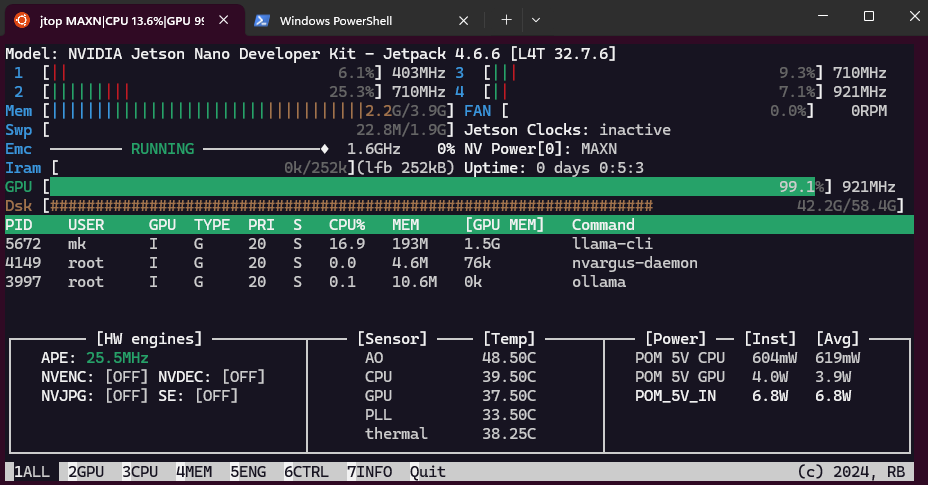
Prerequisites
The following software packages need to be installed. The section “Install prerequisites” describes the process in detail. The installation of gcc 8.5 and cmake 3.27 might take several hours.
- Nvidia CUDA Compiler nvcc 10.2 -
nvcc --version - GCC and CXX (g++) 8.5 -
gcc --version - cmake >= 3.14 -
cmake --version nano,curl,libcurl4-openssl-dev,python3-pipandjtop
Procedure
Newer versions of llama.cpp are constantly relased. We will check out a specific version (b5050 from April 2025) known to be working to ensure this repository keeps working in the future. If you want to try a more recent version remove the steps git checkout 23106f9 and git checkout -b llamaJetsonNanoCUDA in the following instructions:
1. Clone repository
git clone https://github.com/ggml-org/llama.cpp llama5050gpu.cpp
cd llama5050gpu.cpp
git checkout 23106f9
git checkout -b llamaJetsonNanoCUDA
For the next steps 2. to 5. we have to make changes to these 6 files:
- CMakeLists.txt 14
- ggml/CMakeLists.txt 274
- ggml/src/ggml-cuda/common.cuh 455
- ggml/src/ggml-cuda/fattn-common.cuh 623
- ggml/src/ggml-cuda/fattn-vec-f32.cuh 71
- ggml/src/ggml-cuda/fattn-vec-f16.cuh 73
In early 2025 llama.cpp started supporting and using bfloat16, a feature not included in nvcc 10.2. We have two options:
- Option A: Create two new files
- /usr/local/cuda/include/cuda_bf16.h
- /usr/local/cuda/include/cuda_bf16.hpp
- Option B: Edit 3 files
- ggml/src/ggml-cuda/vendors/cuda.h
- ggml/src/ggml-cuda/convert.cu
- ggml/src/ggml-cuda/mmv.cu
Details for each option are described below in step 2 to 7:
2. Add a limit to the CUDA architecture in CMakeLists.txt
Edit the file CMakeLists.txt with nano CMakeLists.txt. Add the following 3 lines after line 14 (with Ctrl+_ you can jump to this line, check line with Ctrl+c):
if(NOT DEFINED ${CMAKE_CUDA_ARCHITECTURES})
set(CMAKE_CUDA_ARCHITECTURES 50 61)
endif()
Save with Ctrl+o and exit with Ctrl+x.
3. Add two linker instructions after line 274 in ggml/CMakeLists.txt
Edit the file with nano ggml/CMakeLists.txt and enter two new lines after set_target_properties(ggml PROPERTIES PUBLIC_HEADER "${GGML_PUBLIC_HEADERS}") and before #if (GGML_METAL). It should then look like:
set_target_properties(ggml PROPERTIES PUBLIC_HEADER "${GGML_PUBLIC_HEADERS}")
target_link_libraries(ggml PRIVATE stdc++fs)
add_link_options(-Wl,--copy-dt-needed-entries)
#if (GGML_METAL)
# set_target_properties(ggml PROPERTIES RESOURCE "${CMAKE_CURRENT_SOURCE_DIR}/src/ggml-metal.metal")
#endif()
With target_link_libraries(ggml PRIVATE stdc++fs) and add_link_options(-Wl,--copy-dt-needed-entries) we avoid some static link issues that don’t appear in later gcc versions. See nocoffei’s comment.
4. Remove constexpr from line 455 in ggml/src/ggml-cuda/common.cuh
Use nano ggml/src/ggml-cuda/common.cuh to remove the constexpr after the static in line 455. This feature from CUDA C++ 17 we don’t support anyway. After that it looks like:
// TODO: move to ggml-common.h
static __device__ int8_t kvalues_iq4nl[16] = {-127, -104, -83, -65, -49, -35, -22, -10, 1, 13, 25, 38, 53, 69, 89, 113};
5. Comment lines containing __buildin_assume by adding “//” in 3 files
Comment the lines by adding a // in front of these 3 files. This avoids the compiler error “__builtin_assume” is undefined.
- line 623,
nano ggml/src/ggml-cuda/fattn-common.cuh - line 71,
nano ggml/src/ggml-cuda/fattn-vec-f32.cuh - line 73,
nano ggml/src/ggml-cuda/fattn-vec-f16.cuh
If you have a version lower than b4400 you can skip the next step.
In January 2025 with version larger than b4400 llama.cpp started including support for bfloat16. There is a standard library cuda_bf16.h in the folder /usr/local/cuda/targets/aarch64-linux/include for nvcc 11.0 and larger. It has more than 5000 lines. One cannot simply copy and paste a version from Cuda 11 to our folder for Cuda 10.2 and hope it would work. The same applies to its companion cuda_bf16.hpp with 3800 lines. Since it is linked to version 11 or 12, the error messages keep expanding (e.g. /usr/local/cuda/include/cuda_bf16.h:4322:10: fatal error: nv/target: No such file or directory). We have two working options:
6. Option A: Create a cuda_bf16.h that redefines nv_bfloat16 as half
Create two new files in the folder /usr/local/cuda/include/, starting with cuda_bf16.h. You need root privileges, so execute sudo nano /usr/local/cuda/include/cuda_bf16.h and give it the following content:
#ifndef CUDA_BF16_H
#define CUDA_BF16_H
#include <cuda_fp16.h>
// Define nv_bfloat16 as half
typedef half nv_bfloat16;
#endif // CUDA_BF16_H
Create the second file sudo nano /usr/local/cuda/include/cuda_bf16.hpp with the content
#ifndef CUDA_BF16_HPP
#define CUDA_BF16_HPP
#include "cuda_bf16.h"
namespace cuda {
class BFloat16 {
public:
nv_bfloat16 value;
__host__ __device__ BFloat16() : value(0) {}
__host__ __device__ BFloat16(float f) { value = __float2half(f); }
__host__ __device__ operator float() const { return __half2float(value); }
};
} // namespace cuda
#endif // CUDA_BF16_HPP
6. Option B: Comment all code related to bfloat16 in 3 files
The second solution is to remove all references to the bfloat16 data type in the 3 files referencing them. First we have to NOT include the nonexisting cuda_bf16.h. Just add two // in front of line 6 with nano ggml/src/ggml-cuda/vendors/cuda.h. After that it looks like this:
#include <cuda.h>
#include <cublas_v2.h>
//#include <cuda_bf16.h>
#include <cuda_fp16.h>
That is not enough, the new data type nv_bfloat16 is referenced 8 times in 2 files. Replace each instance of them with half
- 684 in
ggml/src/ggml-cuda/convert.cu - 60 in
ggml/src/ggml-cuda/mmv.cu - 67 in
ggml/src/ggml-cuda/mmv.cu - 68 in
ggml/src/ggml-cuda/mmv.cu - 235 in
ggml/src/ggml-cuda/mmv.cu(2x) - 282 in
ggml/src/ggml-cuda/mmv.cu(2x)
DONE! Only two more instructions left.
7. Execute cmake -B build with more flags to avoid the CUDA17 errors
We need to add a few extra flags to the recommended first instruction cmake -B build. If not done several errors like Target “ggml-cuda” requires the language dialect “CUDA17” (with compiler extensions) would stop the compilation. We still have a few warnings constexpr if statements are a C++17 feature, but we can ignore them.
cmake -B build -DGGML_CUDA=ON -DLLAMA_CURL=ON -DCMAKE_CUDA_STANDARD=14 -DCMAKE_CUDA_STANDARD_REQUIRED=true -DGGML_CPU_ARM_ARCH=armv8-a -DGGML_NATIVE=off
And 15 seconds later we’re ready for the last step, the instruction that will take 85 minutes (faster SD card: 60 minutes) to have llama.cpp compiled:
cmake --build build --config Release
Successfully compiled!
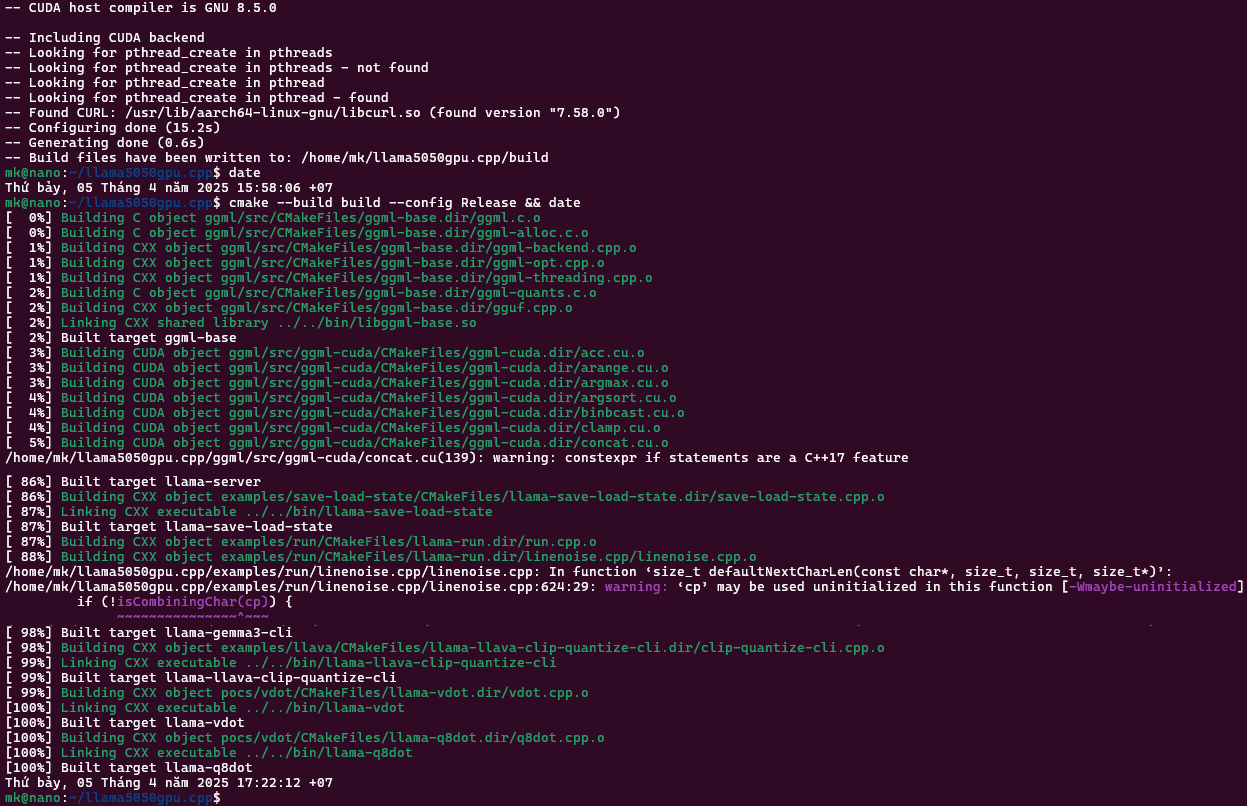
After that you can start a conversation with Gemma3 about finer details of our universe:
./build/bin/llama-cli -hf ggml-org/gemma-3-1b-it-GGUF -p "Explain quantum entanglement" --n-gpu-layers 99

The answers vary, sometimes it throws in a video from Veritasium. And it could easily “Write a 1000 word essay about the French Revolution” with $pp = 21 \frac{token}{s}$ and $tg = 5.13 \frac{token}{s}$. Impressive!
Benchmark
We use the same Jetson Nano machine from 2019, no overclocking settings. The test prompt for llama-cli, ollama and the older main is “Explain quantum entanglement”. Tests include the latest ollama 0.6.4 from April 2025 in CPU mode and several versions of llama.cpp compiled in pure CPU mode and with GPU support, using different amounts of layers offloaded to the GPU. The three LLM models considerd in the benchmarks are:
- 2023-12-31 B1: TinyLlama-1.1B-Chat Q4 K M with 669 MB, 22 layers, 1.1 billion parameters and 2048 context length
- 2025-03-12 B2: Gemma3:1b Q4 K M with 806 MB, 27 layers, 1 billion parameters and 32768 context length
- 2025-04-03 B3: Gemma3:4b_it_qat_q4_0 with 3.16 GB, 35 layers, 3.88 billion parameters, image-to-text support (normalized 896x896) and 128000 total input context
B1: TinyLlama-1.1B-Chat 2023-12-31
The first prompt is for older builds b1618 and b2275 that use main, while b4400 and b5050 use the second llama-cli call. Put the prompt in the cli after the startup.
./main -hf TheBloke/TinyLlama-1.1B-Chat-v1.0-GGUF --n-gpu-layers 25 -p "Explain quantum entanglement"
./build/bin/llama-cli -hf TheBloke/TinyLlama-1.1B-Chat-v1.0-GGUF --n-gpu-layers 25
llama-cli -hf kreier/tiny
llama.cpp has also a build-in benchmark program alled llama-bench, here tested with the CUDA version b5043:
m@n:~/./build/bin/llama-bench -m ../.cache/llama.cpp/TheBloke_TinyLlama-1.1B-Chat-v1.0.Q2_K.gguf --n-gpu-layers 99
ggml_cuda_init: found 1 CUDA devices:
Device 0: NVIDIA Tegra X1, compute capability 5.3, VMM: no
| model | size | params | backend | ngl | test | t/s |
| ---------------------- | ---------: | -----: | ------- | --: | ----: | -----------: |
| llama 1B Q4_K - Medium | 636.18 MiB | 1.10 B | CUDA | 99 | pp512 | 80.57 ± 0.33 |
| llama 1B Q4_K - Medium | 636.18 MiB | 1.10 B | CUDA | 99 | tg128 | 6.69 ± 0.00 |
build: c262bedd (5043)
The prompt processing speed seems to be too high in this benchmark (found the answer a few days later, see explanation later in this document) for the small models run on the Jetson Nano. To have a more realistic comparison for the graph below the llama-cli was used to determine both the pp and tg metrics. Similar results were achieved with longer prompts like “Write a 1000 word essay about the French Revolution”.
Explanation: Earlier editions of llama.cpp like b1618 from December 2023 or b4400 from December 2024 got faster in all their metrics with improvements to their code. The native speed of a CPU compile from April 2025 (b5036) has the same speed (within error) as a CPU build from ollama 0.6.4 from the same time for both pp and tg.
The main metric to compare here is the token generation. Initial versions with GPU acceleration with all layers in December 2023 was slower than the current CPU version (5.25 vs 3.94), by the end of 2024 the GPU is accelerating the token generation, and with CUDA it is around 20% faster (5.25 vs. 6.28 average)! Here just tg in green over CPU/GPU and time:
As expected, the prompt processing is even further accelerated, since it is very compute intensive. But it only contributes to a small time amount of the final answer. Another observation: A GPU optimized version is significantly slower than a CPU optimized version for the Jetson with the shared memory architecture when not all layers are offloaded to the GPU.


B2: Gemma3:1b 2025-03-12
This much more recent model from March 2025 is slightly larger with 806 MB but much more capable than TinyLlama, and comparable in speed. The prompt is “Explain quantum entanglement”
llama-cli -hf ggml-org/gemma-3-1b-it-GGUF --n-gpu-layers 99
llama-cli -hf unsloth/gemma-3-1b-it-GGUF:Q4_K_M
./build/bin/llama-bench -m ../.cache/llama.cpp/ggml-org_gemma-3-1b-it-GGUF_gemma-3-1b-it-Q4_K_M.gguf --n-gpu-layers 0
There is also an integrated benchmark program build/bin/llama-bench -m ggml-org/gemma-3-1b-it-GGUF in llama.cpp. The results for prompt processing seem artificially high (graph and explanation later in this document), but demonstrate a dependence on the number of layers used:
| layers | 0 | 5 | 10 | 15 | 20 | 25 | 27 | CPU |
|---|---|---|---|---|---|---|---|---|
| prompt processing | 96.63 | 97.41 | 100.46 | 105.14 | 109.68 | 113.95 | 115.75 | 7.47 |
| token generation | 2.57 | 2.86 | 3.21 | 3.65 | 4.21 | 5.01 | 5.84 | 4.27 |
A general result of the benchmark looks like this:
ggml_cuda_init: found 1 CUDA devices:
Device 0: NVIDIA Tegra X1, compute capability 5.3, VMM: no
| model | size | params | backend | ngl | test | t/s |
| ----------------------- | ---------: | -------: | ------- | --: | ----: | ------------: |
| gemma3 1B Q4_K - Medium | 762.49 MiB | 999.89 M | CUDA | 27 | pp512 | 115.75 ± 0.08 |
| gemma3 1B Q4_K - Medium | 762.49 MiB | 999.89 M | CUDA | 27 | tg128 | 5.84 ± 0.01 |
build: 193c3e03 (5038)

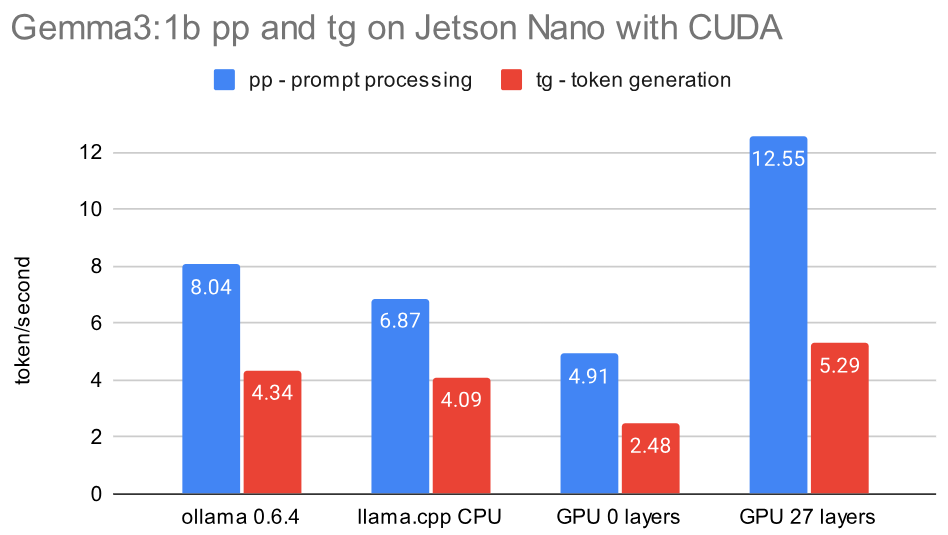
While a compiled CPU version of llama.cpp is comparable in speed with a recent ollama version, so might a GPU version be slower when not offloading layers to the GPU, but be 20% faster if the model is offloaded to the GPU!
Applications for Gemma 3 1b
One might wonder if there are some applications for this small 1 billion parameter model that runs on the Jetson with GPU acceleration. Here are a few I found:
- Fix broken JSON from user gracefully for better UX on reddit, prompt is “Fix syntax issue in this
and respond with corrected JSON but not anything else", The output is a plane JSON and I can take it back to .NET - Fine-Tuning Gemma 3 1B-IT for Financial Sentiment Analysis: A Step-by-Step Guide by Luca Massaron, 2025-03-26 on medium.com
Extended testing with 11 prompts on 3 llm interpreters
To better evaluate the improvements with the GPU usage I tested 11 prompts on ollama 0.6.4 with CPU, llama.cpp b5058 compiled for CPU and then llama.cpp b5050 for GPU. The initial prompt processing now 2.4x faster than ollama and more than 3.1x faster than llama.cpp for CPU. But for our prompts that’s only 1-4 seconds. The more important token generation is 11% faster with CUDA than on CPU with ollama, and on average 25% faster than llama.cpp on CPU. All details can be found in this Google sheet.
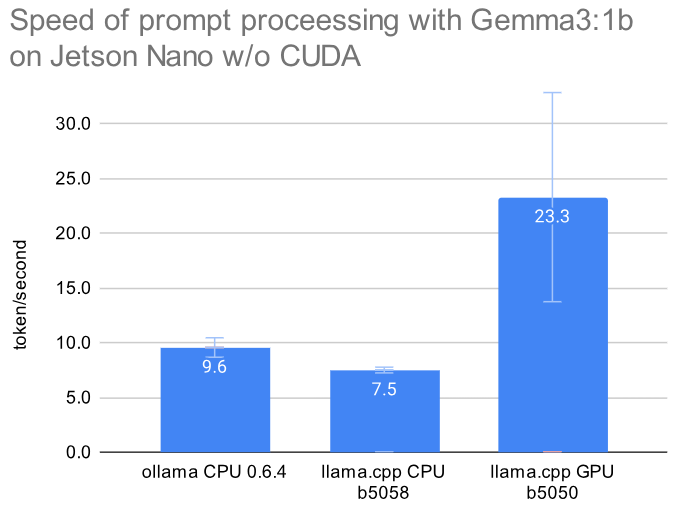
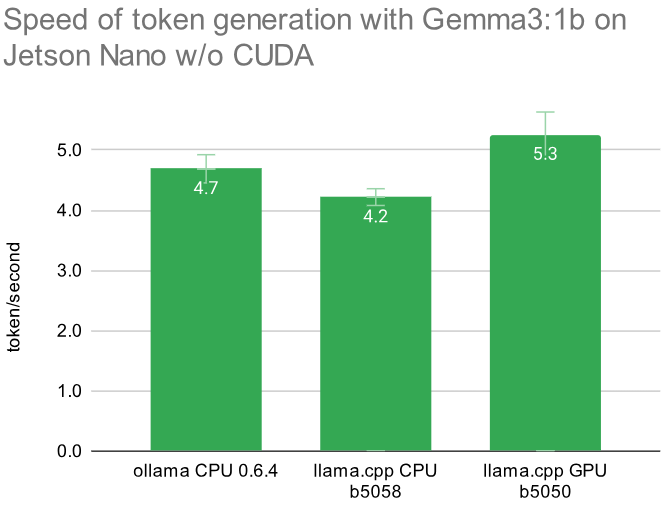
The standard deviation on the prompt processing is rather large, since depending on the prompt the speed varies 11-44 token/second. Here are the numerical values:
| llm software | prompt processing | token generation |
|---|---|---|
| ollama CPU 0.6.4 | 9.56 ± 0.3 | 4.69 ± 0.23 |
| llama.cpp CPU b5058 | 7.5 ± 0.3 | 4.22 ± 0.14 |
| llama.cpp GPU b5050 | 23.29 ± 9.6 | 5.26 ± 0.37 |
Here are the 11 questions or prompts:
- Explain quantum entanglement
- Write a 1000 word essay about the French revolution
- Compare Goldilocks to Cinderella
- Write a python program that generates 100 random strings for a name and family name, and export them as a csv file
- Write a haiku about artificial intelligence
- Explain the fundamental theorem of calculus and its symbols
- What is CRISPR and what can it be used for?
- If a train travels 100 miles in 2 hours, and then travels 50 miles in 1 hour, what is its average speed for the entire trip? Let’s think step by step.
- You are a travel guide. Recommend a 3-day itinerary for someone visiting Tokio, focusing on local culture and food.
- Imagine there is a circular pond in an oasis, with two trees at the edge of the pond, on opposite sides. Bob sets up a hammock by hanging it between the two trees. He gets into the hammock and falls asleep. If he were to roll over in his sleep and fall out of the hammock, where would he fall?
- What is e?
In a combined graph it looks like this:

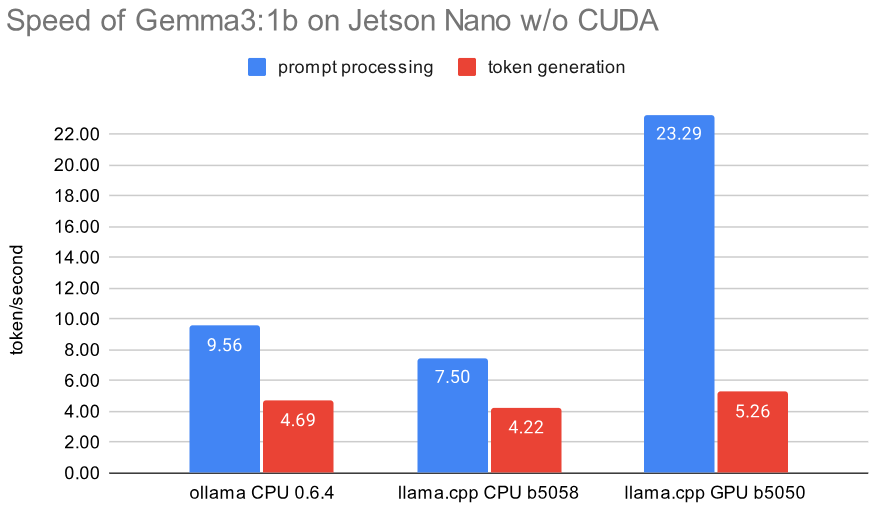
Explaining the variance in prompt processing when using the GPU
The big variance in processing speed for the input tokens was surprizing. Having a closer look it appeared that longer input prompts achieve a faster speed. This would in part explain the very high results when using llama-bench since it labels its speed results as pp512 which is rather large. The 11 prompts from this benchmark range only from 12 to 76 tokens in Gemma3. The following graph visualizes that this dependency from the prompt length exists, while it does not change in CPU mode. And the token generation rate tg is also not affected, this only has a slightly faster generation speed in the first seconds:

You see in the left graph that the token generation with GPU is slightly faster than the CPU mode (blue vs. yellow) for all input lengths. The prompt processing is faster, and with CPU independent of prompt length (red) but faster with longer prompts (green).
Increased speed in token generation when exporting more layers to the GPU
Another parameter affecting the speed of generating an answer is the number of layers exported to the GPU with --n-gpu-layers 99. In this case the prompt processing is largely unaffected, while it more than doubles the speed of the token generation - even with the unified memory of the Jetson Nano. A CPU compile as only 4.27 in token generation:
Reason for GPU 20% faster than CPU
Since inference speed is usually limited by the memory bandwidth (known as “latency bottleneck”) it is surprizing to see some increased speed for the use of the GPU on the shared 4GB LPDDR4 memory with a theoretical speed of 25.60 GB/s. With the CPU I get only 26% or 6.7 GB/s:
mk@jetson:~$ sysbench memory --memory-block-size=32m run
sysbench 1.0.11 (using system LuaJIT 2.1.0-beta3)
68903.00 MiB transferred (6887.13 MiB/sec)
The memory access for the GPU seems to be 2.4x faster with 16.5 GB/s or 64% of the theoretical maximum. Maybe a feature of the MMU? The result is from a compiled bandwidthTest in the sample folder:
mk@nano:/usr/local/cuda/samples/1_Utilities/bandwidthTest$ ./bandwidthTest
[CUDA Bandwidth Test] - Starting...
Running on...
Device 0: NVIDIA Tegra X1
Quick Mode
Host to Device Bandwidth, 1 Device(s)
PINNED Memory Transfers
Transfer Size (Bytes) Bandwidth(GB/s)
32000000 7.1
Device to Host Bandwidth, 1 Device(s)
PINNED Memory Transfers
Transfer Size (Bytes) Bandwidth(GB/s)
32000000 10.3
Device to Device Bandwidth, 1 Device(s)
PINNED Memory Transfers
Transfer Size (Bytes) Bandwidth(GB/s)
32000000 16.5
Result = PASS
NOTE: The CUDA Samples are not meant for performance measurements. Results may vary when GPU Boost is enabled.
B3: Gemma3:4b
One might think that a quantized version of Gemma 3 with 4 billion parameters might work with the 4 GB RAM of the Jetson Nano. And to a degree it does, but not in a usable way. One advantage of the 4B model is its multimodality, so it could also be used for images. It would be slow, but there might be usecases where the Jetson would just crunch images and data in solitude, and we would return next day to examine the results. Well, here is my take on it:
I tried 4 quantization levels: Q2, Q3, Q4 and the original file from Google. Plus the 1b version for comparison.
- 1b:latest - gemma3:1b
- 4b:Q2 - hf.co/unsloth/gemma-3-4b-it-GGUF:Q2_K
- 4b:Q3 - hf.co/unsloth/gemma-3-4b-it-GGUF:Q3_K_M
- 4b:Q4 - hf.co/unsloth/gemma-3-4b-it-GGUF:Q4_K_M
- 4b:latest - gemma3:latest
Here are the sizes of the files and the used memory in Gigabyte with ollama 0.6.4 (April 2025) on Jetson, x86_64 CPU and Nvidia GPU:
| model | file | Jetson | CPU | GPU |
|---|---|---|---|---|
| gemma3:1b | 0.815 | 1.9 | 1.5 | 1.9 |
| hf.co/unsloth/gemma-3-4b-it-GGUF:Q2_K | 1.7 | 1.9 | 3.9 | 4.4 |
| hf.co/unsloth/gemma-3-4b-it-GGUF:Q3_K_M | 2.9 | 2.3 | 4.3 | 4.7 |
| hf.co/unsloth/gemma-3-4b-it-GGUF:Q4_K_M | 3.3 | 2.8 | 4.7 | 5.2 |
| gemma3:latest | 3.3 | – | 5.7 | 6.2 |
With llama.cpp I tried to offload all 37 layers to the GPU, but it only worked for the Q2 quantization. Ollama 0.6.4 worked in pure CPU mode until Q4 on the Jetson with the unsloth variant, but crashed with Google’s version.
| type | pp | tg | pp | tg | pp | tg | pp | tg |
|---|---|---|---|---|---|---|---|---|
| 1b:latest | 17.58 | 5.37 | 12.74 | 4.77 | 71.63 | 31.73 | 76.11 | 166.47 |
| 4b:Q2 | 1.77 | 1.52 | 1.98 | 1.51 | 45.55 | 14.98 | 65.96 | 87.21 |
| 4b:Q3 | – | – | 5.81 | 1.52 | 20.16 | 13.04 | 72.81 | 77.31 |
| 4b:Q4 | – | – | 2.32 | 1.61 | 18.57 | 11.64 | 69.28 | 90.41 |
| 4b:latest | – | – | – | – | 20.51 | 12.69 | 75.67 | 90.25 |
| machine | llama.cpp | llama.cpp | Jetson | Jetson | 13700T | 13700T | 3060Ti | 3060Ti |
Running ollama and llama-server at the same time
With the compiled CUDA version of llama.cpp we can now run ./llama5135.cpp/build/bin/llama-server -m ~/.cache/llama.cpp/kreier_gemma3-1b_gemma3-1b.gguf -ngl 99 --host 0.0.0.0 with 4.7 t/s and ollama run --verbose gemma3:1b with 3.9 token/s at the same time:
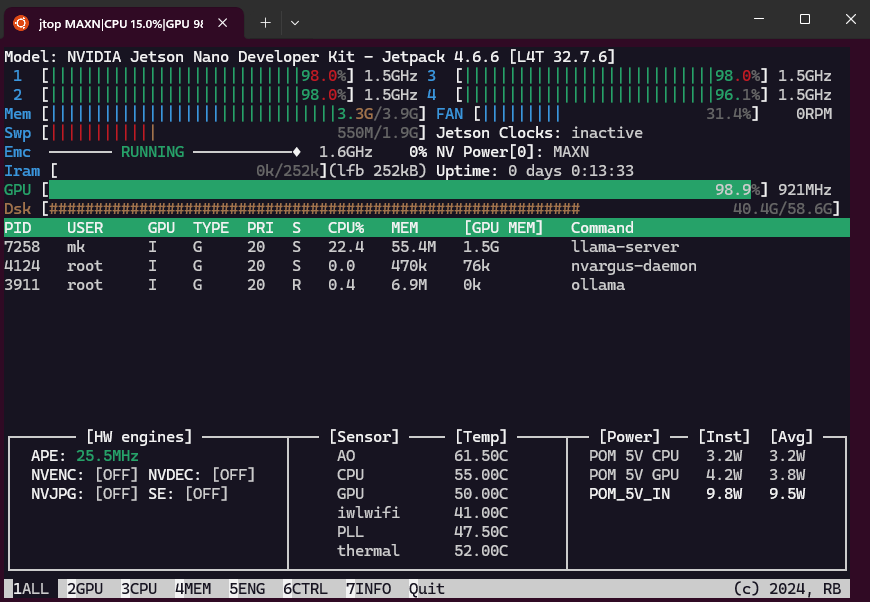
**What do you think? Would you like me to:**
* Write another story?
* Expand on a particular part of this story?
* Suggest a genre (e.g., mystery, fantasy)?
total duration: 3m43.341644716s
load duration: 453.781209ms
prompt eval count: 13 token(s)
prompt eval duration: 1.894296054s
prompt eval rate: 6.86 tokens/s
eval count: 854 token(s)
eval duration: 3m40.892523137s
eval rate: 3.87 tokens/s
>>> /bye
mk@nano:~$ ollama ps
NAME ID SIZE PROCESSOR UNTIL
gemma3:1b 8648f39daa8f 854 MB 100% CPU 53 seconds from now
Without llama-server running the background ollama is only slightly faster with 4.49 t/s (16% faster). The independent systems for CPU and GPU therefore don’t slow down one another very much, even though using the same unified memory.

Compile llama.cpp for CPU mode
This can be done with gcc 8.5 or gcc 9.4 in 24 minutes and was tested with a version as recent as April 2025. You can follow the instructions from llama.cpp. We added the parameter -DLLAMA_CURL=ON to support an easy model download from huggingface with the -hf command:
git clone https://github.com/ggml-org/llama.cpp
cd llama.cpp
cmake -B build -DLLAMA_CURL=ON
cmake --build build --config Release
After finishing the compilation its time for the first model and AI chat:
./build/bin/llama-cli -hf ggml-org/gemma-3-1b-it-GGUF

Install build 5050
The fastest way to get llama.cpp with CUDA support running is installing the compiled files with this script in 44 seconds from this repository:
curl -fsSL https://kreier.github.io/llama.cpp-jetson.nano/install.sh | bash && source ~/.bashrc
The first start with Gemma3 will take almost 7 minutes after main: load model the model and apply lora adapter, if any, but later runs start in 12 seconds:
llama-cli -hf ggml-org/gemma-3-1b-it-GGUF --n-gpu-layers 99
A copy of TinyLlama has the same 6:30 min startup pause at the main: load model the model and apply lora adapter, if any step. It can be started with llama-cli -hf kreier/tiny.
If you downloaded Gemma3:1b with llama-cli -hf kreier/gemma3-1b you can start your webserver with llama-server -m ~/.cache/llama.cpp/kreier_gemma3-1b_gemma3-1b.gguf --host 0.0.0.0 --n-gpu-layers 99.

Install prerequisites
The latest image from Nvidia for the 2019 Jetson Nano contains a ubuntu 18.04 LTS distribution with a kernel Kernel GNU/Linux 4.9.201-tegra, the GNU Compiler Collection 7.5.0 (G++ 7.5.0) from 2019, the NVIDIA Cuda Compiler nvcc 10.3.200 and has Jetpack 4.6.1-b110 (check with sudo apt-cache show nvidia-jetpack) installed. If nvcc --version does not confirm the installed Cuda Compiler you need to update the links with this automated script: curl -fsSL https://kreier.github.io/jetson/fix/cuda-path.sh | bash && source ~/.bashrc or manually with these two lines:
export PATH=/usr/local/cuda/bin${PATH:+:${PATH}}
export LD_LIBRARY_PATH=/usr/local/cuda/lib64${LD_LIBRARY_PATH:+:${LD_LIBRARY_PATH}}
As best practice you can add these to the end of your .bashrc with nano .bashrc.
Update the system - can be skipped
I tested this, and you can skip this step and 2 hours, the procedure works well with the provided older packages. Usually I updated the system and the installed packages to the latest available versions, and with a vanilla image currently about 348 packages have to be updated. Without the upgrade your system states:
- JetPack 4.6.1 (32.7.1-20220219090432) -
dpkg-query --show nvidia-l4t-core - kernel Linux nano 4.9.253-tegra from February 19, 2022 -
uname -a
The upgrade will take several hours. I tested and it is actually not necessary to upgrade to compile llama.cpp. And it is not necessary to run the compiled version of llama.cpp b5050 available here.
sudo apt update
sudo apt upgrade
At two occations you are asked to decide if you want to update a specific settings file. And a third interruption is about starting the docker daemon. All three are towards the end of the update cycle. One of the things updated (perform a reboot) is the jetpack and kernel:
- JetPack 4.6.6 (L4T 32.7.6-20241104234540) -
dpkg-query --show nvidia-l4t-core - kernel Linux nano 4.9.337-tegra from November 4, 2024 -
uname -a
Now there are 3 further things to install or update:
- 4 minutes: a few additional packages like
jtopto check system activity - 38 minutes: cmake >= 3.14 (we chose 3.27)
- 3 hours: gcc 8.5.0 (it works with 9.4 too, if not to export to another machine - then only 4 minutes)
Install additional helpful packages
sudo apt update
sudo apt install nano curl libcurl4-openssl-dev python3-pip
pip3 -H install -U jetson-stats
The last one jetson-stats can be called later as jtop.


Install cmake >= 3.14
Purge any old cmake installation and install a newer 3.27. It will take 38 minutes (bootstrap and make each take 18 minutes).
sudo apt-get remove --purge cmake
sudo apt-get install libssl-dev
wget https://cmake.org/files/v3.27/cmake-3.27.1.tar.gz
tar -xzvf cmake-3.27.1.tar.gz
cd cmake-3.27.1
./bootstrap
make -j4
sudo make install
Choosing the right compiler
GCC 9.4
This compiler from June 1, 2021 can be easily installed from an apt repository in a few minutes, using
sudo apt install build-essential software-properties-common manpages-dev -y
sudo add-apt-repository ppa:ubuntu-toolchain-r/test -y
sudo apt update
sudo apt install gcc-9 g++-9 -y
sudo update-alternatives --install /usr/bin/gcc gcc /usr/bin/gcc-9 9
sudo update-alternatives --install /usr/bin/g++ g++ /usr/bin/g++-9 9
Yet versions 9 and higher are not compatible with nvcc 10.2 and show error: #error -- unsupported GNU version! gcc versions later than 8 are not supported!. The reasons are found in line 136 of /usr/local/cuda/targets/aarch64-linux/include/crt/host_config.h:
#if defined (__GNUC__)
#if __GNUC__ > 8
#error -- unsupported GNU version! gcc versions later than 8 are not supported!
#endif /* __GNUC__ > 8 */
You can edit this line. Change 8 to a 9 with sudo nano /usr/local/cuda/targets/aarch64-linux/include/crt/host_config.h in line 136. Then the compilation is the same as with 8.5, and the installation is much faster, just 4 minutes instead of 3 hours! The created files rely on the library /usr/lib/aarch64-linux-gnu/libstdc++.so.6 being linked to /usr/lib/aarch64-linux-gnu/libstdc++.so.6.0.32. But gcc 7.5 has only libstdc++.so.6.0.25, so the compiled binary will thrown an error if running on a system with only gcc 7.5. Just copying this library and updating the link leads to a crash shortly after starting the CUDA part, don’t know why yet. But gcc 9.4 is useful for test purposes. Version gcc 8.5 uses the older library 6.0.25 that is shipped with gcc 7.5. So 9.4 is good for fast testing, 8.5 better for long term compatibility.
GCC 8.4
This compiler version 8.4 from March 4, 2020 can be installed in the same fast fashion as the mentioned 9.4 above. Will run 24 seconds, with all steps 2 minutes. Just replace three lines:
sudo apt install gcc-8 g++-8 -y
sudo update-alternatives --install /usr/bin/gcc gcc /usr/bin/gcc-8 8
sudo update-alternatives --install /usr/bin/g++ g++ /usr/bin/g++-8 8
But it throws an error on llama.cpp/ggml-quants.c line 407 with:
~/llama.cpp/ggml-quants.c: In function ‘ggml_vec_dot_q3_K_q8_K’:
~/llama.cpp/ggml-quants.c:407:27: error: implicit declaration of function ‘vld1q_s8_x4’; did you mean ‘vld1q_s8_x’? [-Werror=implicit-function-declaration]
#define ggml_vld1q_s8_x4 vld1q_s8_x4
It seems that in version 8.4 the ARM NEON intrinsic vld1q_s8_x4 is treated as a built-in function that cannot be replaced by a macro. It might be related to a fix from ktkachov on 2020-10-13 as one of the 199 bug fixes leading to 8.5. Let’s use the next version:
GCC 8.5
This version was released May 14, 2021. Unfortunately this version is not yet available for ubuntu 18.04 on ppa:ubuntu-toolchain-r/test. We have to compile it by ourselves, and this takes some 3 hours (for the make -j$(nproc) step). The steps are:
sudo apt-get install -y build-essential software-properties-common
sudo apt-get install -y libgmp-dev libmpfr-dev libmpc-dev
wget http://ftp.gnu.org/gnu/gcc/gcc-8.5.0/gcc-8.5.0.tar.gz
tar -xvzf gcc-8.5.0.tar.gz
cd gcc-8.5.0
./contrib/download_prerequisites
mkdir build && cd build
../configure --enable-languages=c,c++ --disable-multilib
make -j$(nproc) # Use all CPU cores
sudo make install
sudo update-alternatives --install /usr/bin/gcc gcc /usr/local/bin/gcc 100
sudo update-alternatives --install /usr/bin/g++ g++ /usr/local/bin/g++ 100
Library libstdc++ updated with gcc 9.x
Code compiled with gcc 8.5 runs without a problem on systems only having gcc 7.5 installed (default for the Ubuntu 18.04.6 LTS image provided by Nvidia) since the standard library libstdc++ is version 6.0.25 for both. It is only updated for the 9.x version of gcc, and then compiled binaries throw an error.
| version | release | libstdc++ | GLIBCXX | /usr/lib/gcc/~/version |
|---|---|---|---|---|
| 7.5.0 | 2019-11-14 | 6.0.25 | 3.4.25 | |
| 8.4.0 | 2020-03-04 | 6.0.25 | 3.4.25 | |
| 8.5.0 | 2021-05-14 | 6.0.25 | 3.4.25 | ~/8/3.4.25 |
| 9.4.0 | 2021-06-01 | 6.0.32 | 3.4.32 | ~/9/3.4.32 |
| 13.3.0 | 2024-05-21 | 6.0.33 | 3.4.33 | ~/13/3.4.33 |
- GCC versions: https://gcc.gnu.org/releases.html
ll /usr/lib/aarch64-linux-gnu/libstd*strings /usr/lib/aarch64-linux-gnu/libstdc++.so.6 | grep GLIBCXXstrings /usr/lib/gcc/aarch64-linux-gnu/7/libstdc++.so | grep GLIBCXXstrings /usr/lib/gcc/aarch64-linux-gnu/8/libstdc++.so | grep GLIBCXXstrings /usr/lib/gcc/aarch64-linux-gnu/9/libstdc++.so | grep GLIBCXX
History
As of April 2025 the current version of llama.cpp can be compiled for the Jetson Nano from 2019 with GPU/CUDA support using gcc 8.5 and nvcc 10.2. Here is a list of a few earlier solutions with description, sorted by their build date. Their performance is later compared in benchmarks:
- 2025-04-05 b5050 Some extra steps had to be included to handle the new support of
bfloat16in llama.cpp since January 2025. Procedure is described in this gist. After 24 revisions it became the foundation for this repository. - 2024-12-31 b4400 Following the steps from the gist above, step 6 can be ommited. Source: a build for the Nintendo Switch!
- 2024-02-26 b2275 A gist by Flor Sanders from 2024-04-11 describes the procedure to combile a version with GPU acceleration.
- 2023-12-07 b1618 A medium.com article from Anurag Dogra from 2025-03-26 describes the modification needed to compile llama.cpp with
gcc 8.5and CUDA support.
Sources
- 2025-03-26 LLAMA.CPP on NVIDIA Jetson Nano: A Complete Guide, Running LLAMA.cpp on Jetson Nano 4 GB with CUDA 10.2 by Anurag Dogra on medium.com. His modifications compile an older version of llama.cpp with
gcc 8.5successfully. Because the codebase for llama.cpp is rather old, the performance with GPU support is significantly worse than current versions running purely on the CPU. This motivated to get a more recent llama.cpp version to be compiled. He uses the version 81bc921 from December 7, 2023 - b1618 of llama.cpp. - 2025-01-13 Guide to compile a recent llama.cpp with CUDA support for the Nintendo Switch at nocoffei.com, titled “Switch AI ✨”. The Nintendo Switch 1 has the same Tegra X1 CPU and Maxwell GPU as the Jetson Nano, but 256 CUDA cores instead of just 128, and a higher clock rate. This article was the main source for this gist.
- 2024-04-11 Setup Guide for
llama.cppon Nvidia Jetson Nano 2GB by Flor Sanders in a gist. He describes the steps to install thegcc 8.5compiler on the Jetson. In step 5 he checks out the version a33e6a0 from February 26, 2024 - b2275 - 2024-05-04 Add binary support for Nvidia Jetson Nano- JetPack 4 #4140 on issues for ollama. In his initial statement dtischler assumes llama.cpp would require gcc-11, but it actually compiles fine with gcc-8 in version 8.5 from May 14, 2021 as shown in this gist.
Footnotes
- Using ollama and checking the system with
ollama psgives a high percentage of GPU usage as an answer. But as can be confirmed withjtop, the GPU is actually not used. Neither can we see GPU memory used, nor a percentage of utilization, nor the power draw for the GPU increasing. The metrics provided by ollama are obviously not correct.


